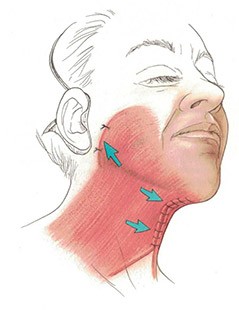Platysmaplasty
A platysmaplasty is neck surgical procedure that aims to tighten and elevate the platysma muscle. This muscle can create vertical muscle bands in the neck as well as generalised fullness in the neck. The muscle may also contribute to jowls, along the jawline
Cosmetic surgery is a serious decision. Information about the risks of this surgery can be found here.
What is the platysma muscle?
The platysma is a thin sheet-like layer of muscle that sits just below the skin of the neck and jawline. There is often a gap in the midline. It is actually quite a large muscle that extends all the way from down in the pectoral (chest) and deltoid (shoulder muscles) before sliding over the collarbone to proceed up into the neck. The purpose of the muscle is to draw the lower lip and corner of the mouth sideways and downwards in what is often described as an expression of surprise or fright.
As we age the gap in the midline of the platysma often becomes wider so that the muscle looks like two completely separate muscles. With time and gravity the fibres that join the platysma to the skin begin to weaken and the muscle can move downwards.
The platysma can cause the following unwanted changes in the neck:
- Vertical neck bands or other lines
- Double chin
- Excess skin
- Prominent jowls along the jawline and chin
What is a platysmaplasty procedure?

A plastysmaplasty involves tightening the platysma muscle and lifting it upwards. Typically a small incision (approximately 1-3 cm) needs to be made under the chin to access the area where the two muscle bands have separated causing vertical neck bands. These can then be sutured together in the midline. Dr Roth uses fibreoptic telescopes in a keyhole manner to identify the muscle and excess fat. Sometimes liposuction is performed at the same time. Once the muscle is joined in the midline we call this a “midline platysma plication”. This new sheet of muscle is strong and is very resistant to bands in the neck reforming. This procedure is sometimes called a “corset platysmaplasty”.
The platysma muscle can then be lifted from an area up near the ears to tighten it further and address excess skin and jowls. This requires an additional incision hidden in and around the ears. Most patients over the age of 40 will need this additional lift from the sides and this procedure is then best name a “neck lift” or “lower facelift”. Excess skin can be removed from around the ear once the neck muscles have been lifted.
A plastysmaplasty is a smaller procedure than a full facelift and does not rejuvenate the midface, eye or brow areas. These are best addressed through a deep plane facelift.
What is the recovery time after a platysmaplasty?

The platysma is a broad sheet of muscle in the neck containing two halves extending from the chest and should to the jawline
Upon waking from surgery the neck will feel tight. This is normal and is expected, you have had a neck tightening procedure. The sensation of tightness settles gradually as healing progresses. Usually patients needs a few days of downtime. Some patients develop bruising and swelling along the jawline and neck which may take a week to subside.
The results from a platysmaplasty are visible immediately after surgery and continue to improve over approximately 12 weeks.
Am I a good candidate for a platysmaplasty?

In the face the platysma muscle blends with the other muscles of facial expression and the parotideo-masseteric fascia. It can be lifted as part of a a facelift or neck lift.
Everybody’s anatomy is different and the best way to find out if you are a good candidate for a platysmaplasty is with an in-person consultation. Dr Roth consults most weeks out of his office on Sydney’s Northern Beaches. During your consultation Dr Roth will listen carefully to your cosmetic concerns and will help advise on what procedure would be most appropriate.

